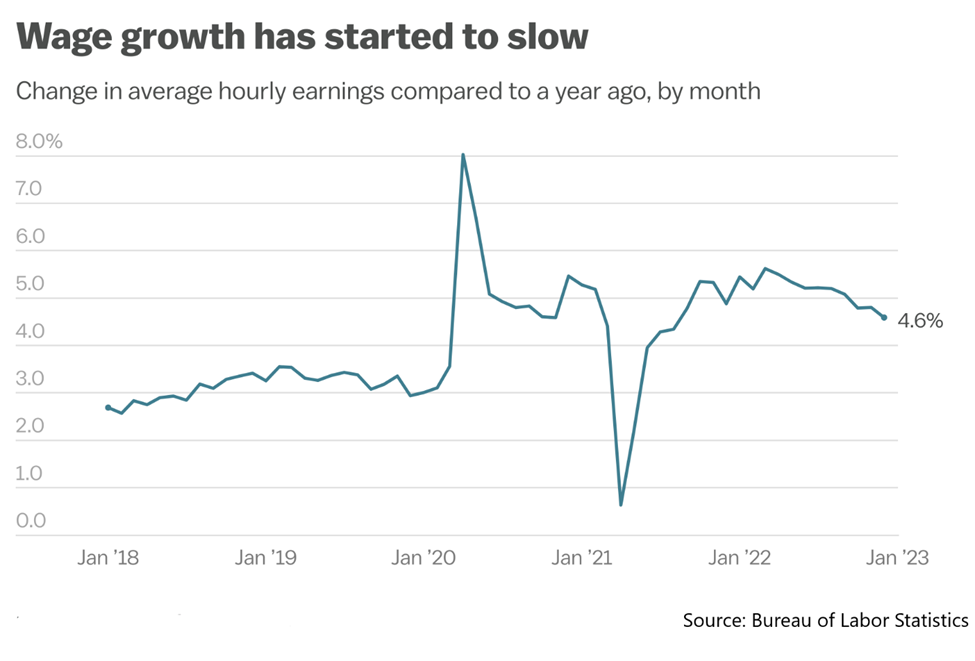Continuous growing wages contribute to expand inflation which puts the Federal Reserve in a difficult situation regarding price increases control.
During and because of the Covid pandemic, businesses have confronted a serious labor shortage which has caused paychecks to grow fast. In other words, firms have found themselves under the obligation of retaining workers, and to do that they have raised wages which has led to an automatic raise in prices for clients. Thus, more fuel on inflation.
Nevertheless, wages are slowing down lately. This is certainly not good news for workers, but for Federal Reserve – which states its will of seeing growth back in a sustainable level – it’s a good sign. Officials of Federal Reserve put wages under a nonstop scrutiny, because if growth is strong, inflation gets stimulated; this would eat into the wage gains of the Americans when goods get more expensive and would make the goal of 2% inflation more complex for the Fed.
At a press conference on December 14th, Fed officer Jerome Powell said: “We want strong wage increases. We just want them to be at a level that’s consistent with 2 percent inflation.”
Considering history, inflation has been outpaced by wage growth by around 1%. Today, inflation as well as wage growth have abnormally grown even higher. In spite of the rapid paychecks’ growth, for many workers wage gains have been outrun by inflation.
During December, the average earnings per hour has grown by 4.6% compared to the previous year. Wage gains increased by around 5.1% in 2022 in comparison to the year before. The average earnings per hour is calculated by dividing the full salary income of the worker by the work hours number.

Despite the slowdown of the inflation in the past few months, wage gains still have been outpaced by price augmentations during almost all the pandemic. According to a report of Consumer Price Index, prices made a 6.5 % raise in December compared to last year. The inflation deceleration of previous month was merely a result of lower fuel, airline fare fees as well as used cars.
For some workers though, wage gains have been faster than they have for others. According to the wage growth tracker of Atlanta Federal Reserve Bank, wage gains have risen chiefly for workers with lower skills. Additionally, per-hour workers’ wages increased by 6.5 % in comparison with 5.9 % of other workers.

Kathy Bostjancic, the Nationwide economist, said that a wage gain slowdown can be a solution to alleviate inflation since the costs of businesses, then, would be less high. This means recruiters would probably not have the need to raise products’ prices so as to compensate costs. This applies to service-offering businesses, because compensating employers for them is of major importance. Also, non-rapid growth of income can alleviate the demands of consumers, because there won’t be as much earnings to be spent.
Though Bostjancic mentioned that – given some reasons – the persistence of wage gains is likely, she on the other hand expected – due to workers’ demand drop-off – a slowdown in wage growth during the year. Regardless of the hiring deceleration, thousands of jobs are still added to the economy in a monthly basis. Being the lowest number in the last 50 years, the rate of unemployment now is 3.5 %.
Bostjancic sais: “You’re still seeing the lack of skilled labor remain an issue for companies.”
Aaron Sojourner – a researcher and labor economist at the W.E. Upjohn Institute for Employment Research – said that: according to Federal Reserve officials, wage growth is generally viewed as a signal for general inflation, which makes investigating wage gains mandatory, for they have the ability to affect how interest rates are lifted by the Federal Reserve.
In the past year, the Federal Reserve began to raise the rates of interest. This caused things like ‘money borrowing’ and ‘mortgage taking’ more expensive. Aiming to slow price increases, the Federal Reserve is attempting to put a curb on consumer demands. Yet, policymakers are in challenging situation; because the act of slowing down economy in order to decelerate inflation may end up causing an inadmissible employment augmentation. As a response to slow demand and high interest rates, businesses may discharge employees and/or reduce creating jobs.
Rates have been dramatically lifted by the central bank; after linear increases of ¾, rates were raised by 0.5 % in December. Forecasters of economy expect rates to be lifted by a quarter percent during the coming meeting at the central bank.
Sojourner said: “I think the Fed isn’t sure and is skeptical of the idea that wages can rise much faster than broad prices for a long time. The Fed wants to see the growth rate of wages coming down.”
While there is a calm down in the market of labor, there has consequently been a slowdown in wage growth. The ZipRecruiter chief economist, Julia Pollak, said that for many reasons wage growth in the beginning of the pandemic was more rapid. She said that employees, for instance, required more compensation for putting their health at risk while working manually. Besides, employers themselves had to increase benefits and raise incomes because the number of workers was very limited due to the difficult public transportation access and the shutdown of schools.
According to some economists, data illustrates that recently wage growth and price growth have been similar.
Pollak said: “That is likely to continue and that effect actually could get bigger because we are seeing inflation coming down pretty rapidly.”
After reaching a potential 9.1% peak in June, economists predict inflation to keep slowing down in the upcoming months. This came as a result of the supply chains’ recovery that has brought about some pressure off goods’ prices. Data also shew that new leases of rent prices have been going down. It is expected that in the next months, rent costs will enormously slow down.
The Dreyfus and Mellon macro strategist and chief economist states that average earning per hour will go back to a steadier rate of 3.5 %. Reinhart added that unemployment was at a very low rate that the number of the job openings was twice that of unemployed people.
“There should be a lot of pressure on wages. They can’t take it as given that just because the last couple of months were favorable, underlying conditions are favorable,” said the chief economist.
YOU WANT TO KNOW MORE ABOUT ‘INFLATION’ vs ‘RISING WAGES’? consider the following video






